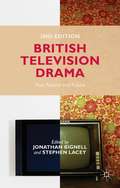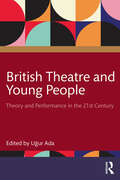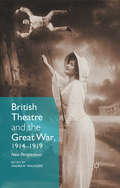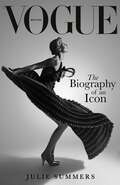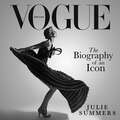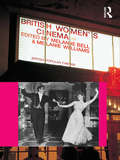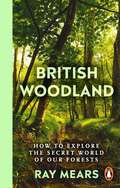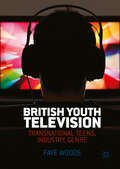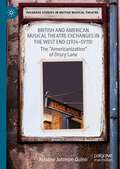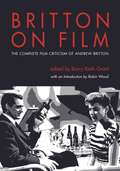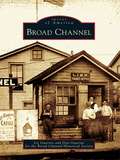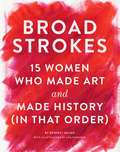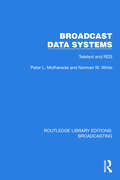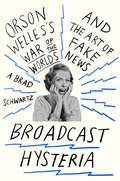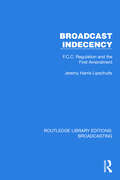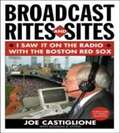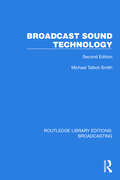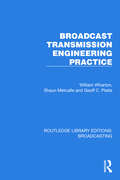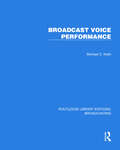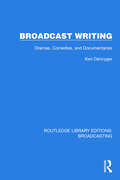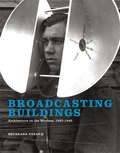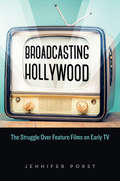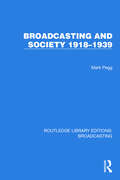- Table View
- List View
British Television Drama: Past, Present And Future
by Jonathan Bignell Stephen LaceyFeaturing leading scholars of British television drama and noted writers and producers from the television industry, this new edition of British Television Drama evaluates past and present TV fiction since the 1960s, and considers its likely future.
British Theatre and Young People: Theory and Performance in the 21st Century
by Uğur AdaBritish Theatre and Young People gathers together new and original studies on the issues, theories, practices and perceptions which characterise British theatre about, for, by, and with young people in the 21st century.Interrogating the critical relationship between theatre and young people today, the book brings together perspectives on theatre about, for, by, and with young people and presents it as an art form in its own right. The first part of the book focuses on applied and socially engaged theatre practice with young people, illustrating the ways in which theatre can highlight inclusivity, well-being, community and politics among young people. Part two presents essays on adaptation and appropriation, generally looking at how classic texts have been adapted for young audiences. Finally, the last part of the book looks at the ways in which British Youth Theatre and practice in the UK has impacted regional and national theatre scenes. Highlighting this rich and active community and practice, this edited collection paints a picture of the state of theatre for and by young people in the UK today.British Theatre and Young People is ideal for undergraduate and postgraduate students of theatre studies and applied theatre with an interest in British theatre.
British Theatre and the Great War, 1914 - 1919: New Perspectives
by Andrew MaunderBritish Theatre and the Great War examines how theatre in its various forms adapted itself to the new conditions of 1914-1918. Contributors discuss the roles played by the theatre industry. They draw on a range of source materials to show the different kinds of theatrical provision and performance cultures in operation not only in London but across parts of Britain and also in Australia and at the Front. As well as recovering lost works and highlighting new areas for investigation (regional theatre, prison camp theatre, troop entertainment, the threat from film, suburban theatre) the book offers revisionist analysis of how the conflict and its challenges were represented on stage at the time and the controversies it provoked. The volume offers new models for exploring the topic in an accessible, jargon-free way, and it shows how theatrical entertainment of the time can be seen as the `missing link’ in the study of First World War writing.
British Vogue: The Biography of an Icon
by Julie SummersA glittering official history of British Vogue, telling the magazine's story from the first issue in 1916 right up to the present day, written with exclusive access to the Vogue archives.British Vogue has always been far more than just a fashion magazine. For more than a century it has defined the tastes and style of successive generations, playing a leading role in the continuing story of Britain's national identity, and covering the arts, politics, health, travel and much more in addition to the fashion pages. It is an institution and a character in its own right. Now, for the very first time, the fascinating and glamorous history of British Vogue is told in full. Founded in 1916, British Vogue has forged its own path from the very start. From the trauma and austerity of two world wars through to the freedom of the swinging Sixties, the rise of the supermodel to the groundbreaking editorial direction of Edward Enninful: the magazine's chameleonic ability to move with the times has ensured its perennial status at the vanguard of British cool.Beautifully illustrated with exclusive images from the Vogue photographic collections, the book draws on hitherto unseen archives and behind-the-scenes interviews with Vogue insiders including stylist Grace Coddington, editor Alexandra Shulman and fashion editor Lucinda Chambers. This is the story of a legend and the individuals who created (and curated) it, told against the backdrop of an extraordinary century of change, upheaval and beauty.
British Vogue: The Biography of an Icon
by Julie SummersA glittering official history of British Vogue, telling the magazine's story from the first issue in 1916 right up to the present day, written with exclusive access to the Vogue archives.British Vogue has always been far more than just a fashion magazine. For more than a century it has defined the tastes and style of successive generations, playing a leading role in the continuing story of Britain's national identity, and covering the arts, politics, health, travel and much more in addition to the fashion pages. It is an institution and a character in its own right. Now, for the very first time, the fascinating and glamorous history of British Vogue is told in full. Founded in 1916, British Vogue has forged its own path from the very start. From the trauma and austerity of two world wars through to the freedom of the swinging Sixties, the rise of the supermodel to the groundbreaking editorial direction of Edward Enninful: the magazine's chameleonic ability to move with the times has ensured its perennial status at the vanguard of British cool.Beautifully illustrated with exclusive images from the Vogue photographic collections, the book draws on hitherto unseen archives and behind-the-scenes interviews with Vogue insiders including stylist Grace Coddington, editor Alexandra Shulman and fashion editor Lucinda Chambers. This is the story of a legend and the individuals who created (and curated) it, told against the backdrop of an extraordinary century of change, upheaval and beauty.
British Women's Cinema (British Popular Cinema)
by Melanie Williams Melanie BellBritish Women’s Cinema examines the place of female-centred films throughout British film history, from silent melodrama and 1940s costume dramas right up to the contemporary British ‘chick flick’.
British Woodland: How to explore the secret world of our forests
by Ray MearsNobody sees and understands woodland better than Ray Mears.With deep natural history knowledge and practical woodcraft skills, gained over a lifetime of learning from the world's last remaining indigenous peoples, Ray offers a different way to experience our wooded landscapes. He challenges the old concepts. He looks to our ancestors and shows how man's hand in shaping woodland is critical. We are not separate from nature, we just need to ensure that our interactions have a positive impact.With the emphasis on interaction, British Woodland is structured by usage. We learn that sycamore and clematis are among the best woods for burning, pine and oak help us navigate, and hawthorn and beech have edible leaves. Rope can be made from willow, utensils and tools from hazel, and historically, weapons were made from yew and wych elm.With Ray as our guide, encouraging this sense of connection to individual trees, our appreciation of wooded landscapes will change. We can learn how to live inclusively in nature, for our own wellbeing and enjoyment, and also for the future of our planet.
British Youth Television: Transnational Teens, Industry, Genre
by Faye WoodsIn this book, Faye Woods explores the raucous, cheeky, intimate voice of British youth television. This is the first study of a complete television system targeting teens and twenty somethings, chronicling a period of significant industrial change in the early 21st century. British Youth Television offers a snapshot of the complexities of contemporary television from a British standpoint -- youth-focused programming that blossomed in the commercial expansion of the digital era, yet indelibly shaped by public service broadcasting, and now finding its feet on proliferating platforms. Considering BBC Three, My Mad Fat Diary, The Inbetweeners, Our War and Made in Chelsea, amongst others; Woods identifies a television that is defiantly British, yet also has a complex transatlantic relationship with US teen TV. This book creates a space for British voices in an academic and cultural landscape dominated by the American teenager.
British and American Musical Theatre Exchanges in the West End: The “Americanization” of Drury Lane (Palgrave Studies in British Musical Theatre)
by Arianne Johnson QuinnThis monograph centres on the history of musical theatre in a space of cultural significance for British identity, namely the Theatre Royal, Drury Lane, which housed many prominent American productions from 1924-1970. It argues that during this period Drury Lane was the site of cultural exchanges between Britain and the United States that were a direct result of global engagement in two world wars and the evolution of both countries as imperial powers. The critical and public response to works of musical theatre during this period, particularly the American musical, demonstrates the shifting response by the public to global conflict, the rise of an American Empire in the eyes of the British government, and the ongoing cultural debates about the role of Americans in British public life. By considering the status of Drury Lane as a key site of cultural and political exchanges between the United States and Britain, this study allows us to gain a more complete portrait of the musical’s cultural significance in Britain.
Britton on Film: The Complete Film Criticism of Andrew Britton
by Andrew Britton Barry Keith Grant Robin WoodFor fifteen years before his untimely death, Andrew Britton produced a body of undeniably brilliant film criticism that has been largely ignored within academic circles. Though Britton's writings are extraordinary in their depth and range and are closely attuned to the nuances of the texts they examine, his humanistic approach was at odds with typical theory-based film scholarship. Britton on Film demonstrates that Britton's humanism is also his strength, as it presents all of his published writings together for the first time, including Britton's persuasive readings of such important Hollywood films as Meet Me in St. Louis, Spellbound, and Now, Voyager and of key European filmmakers such as Sergei Eisenstein, Jean-Luc Godard, and Bernardo Bertolucci. Renowned film scholar and editor Barry Keith Grant has assembled all of Britton's published essays of film criticism and theory for this volume, spanning the late 1970s to the early 1990s. The essays are arranged by theme: Hollywood cinema, Hollywood movies, European cinema, and film and cultural theory. In all, twenty-eight essays consider such varied films as Hitchcock's Spellbound, Jaws, The Exorcist, and Mandingo and topics as diverse as formalism, camp, psychoanalysis, imperialism, and feminism. Included are such well-known and important pieces as "Blissing Out: The Politics of Reaganite Entertainment" and "Sideshows: Hollywood in Vietnam," among the most perceptive discussions of these two periods of Hollywood history yet published. In addition, Britton's critiques of the ideology of Screen and Wisconsin formalism display his uncommon grasp of theory even when arguing against prevailing critical trends. An introduction by influential film critic Robin Wood, who was also Britton's teacher and friend, begins this landmark collection. Students and teachers of film studies as well as general readers interested in film and American popular culture will enjoy Britton on Film.
Broad Channel (Images of America)
by Dan Guarino Liz Guarino Broad Channel Historical SocietyBroad Channel is considered a small town in the big city. From its houses perched on stilts over the waters of Jamaica Bay to pairs of mute swans swimming across the waters of a popular beach of yesteryear, it is hard to believe Broad Channel lies within the boundaries of New York City. The only inhabited island in Jamaica Bay, it arose from the area known as Big Egg Marsh on navigational charts. It began as a fishermen's haven and grew into a summer vacation playground with fine hotels. During Prohibition, with bootleg liquor easily smuggled by boat, the isolated island became known as a rumrunner's paradise and became home to several speakeasies. Through vintage images, Broad Channel explores the area's boardwalks and unpaved roads to celebrate the community's rich history.
Broad Strokes: 15 Women Who Made Art and Made History (in That Order)
by Bridget QuinnHistorically, major women artists have been excluded from the mainstream art canon. Aligned with the resurgence of feminism in pop culture, Broad Strokes offers an entertaining corrective to that omission. Art historian Bridget Quinn delves into the lives and careers of 15 female artists from around the globe in text that's smart, feisty, educational, and an enjoyable read. Replete with beautiful reproductions of the artists' works and contemporary portraits of each artist by renowned illustrator Lisa Congdon, this is art history from the Renaissance to Abstract Expressionism for the modern art lover, reader, and feminist.
Broadcast Data Systems: Teletext and RDS (Routledge Library Editions: Broadcasting #6)
by Peter L. Mothersole Norman W. WhiteBroadcast Data Systems (1990) looks at the broadcasting technology of data transmission over TV and radio channels – commonly known as teletext and RDS. It describes the development of the technology, together with the data signal format and coding methods used, the networking of teletext data signals and regional services requirements, and the transmission of the data itself.
Broadcast Graphics On the Spot: Timesaving Techniques Using Photoshop and After Effects for Broadcast and Post Production
by Richard HarringtonPacked with more than 350 techniques, this book delivers what you need to know - on the spot. If you create graphics for television, this book is for you. 'Broadcast Graphics on the Spot' show you how to produce more compelling TV graphics. From gathering images for use in broadcast graphics to working with fonts, mastering keying and rotoscoping, or working with logo motion, this book includes step-by-step procedures for creating over-the-shoulder graphics for news anchors, lower thirds, titles, and full-screens that can be used in everyday news productions.
Broadcast Hysteria: Orson Welles's War of The Worlds and The Art of Fake News
by A. Brad SchwartzIn Broadcast Hysteria, A. Brad Schwartz examines the history behind the infamous radio play. Did it really spawn a wave of mass hysteria? Schwartz is the first to examine the hundreds of letters sent directly to Orson Welles after the broadcast. He draws upon them, and hundreds more sent to the FCC, to recapture the roiling emotions of a bygone era, and his findings challenge conventional wisdom. Relatively few listeners believed an actual attack was underway. But even so, Schwartz shows that Welles's broadcast prompted a different kind of "mass panic" as Americans debated the bewitching power of the radio and the country's vulnerabilities in a time of crisis. Schwartz's original research, storytelling, and thoughtful analysis make Broadcast Hysteria a groundbreaking work of media history.
Broadcast Indecency: F.C.C. Regulation and the First Amendment (Routledge Library Editions: Broadcasting #7)
by Jeremy H. LipschultzBroadcast Indecency (1997) treats broadcast indecency as more than a simple regulatory problem in American law. The author’s approach cuts across legal, social and economic concerns, taking the view that media law and regulation cannot be seen within a vacuum that ignores cultural realities. It treats broadcast as a phenomenon challenging the policy approach of government regulation, and is an exploration of the political and social processes involved in the government control of mass media content.
Broadcast Rites and Sites: I Saw it on the Radio with the Boston Red Sox
by Joe Castiglione Douglas LyonsVeteran broadcaster Joe Castiglione has seen his share of heartbreaking games, especially from his vantage point at Fenway Park where he has called the Red Sox games for the last 20 years. In his newest book, Castiglione not only recounts the drama from the booth in Boston, but also his travels and baseball adventures throughout the country in his previous stints with the Cleveland Indians and Milwaukee Brewers over his 30-year career.
Broadcast Sound Technology (Routledge Library Editions: Broadcasting #8)
by Michael Talbot-SmithBroadcast Sound Technology (1995) covers the basic principles of all the main aspects of the broadcast chain, including microphones and loudspeakers technology, mixing consoles, recording and replay (analogue and digital) and the principles of stereo.
Broadcast Transmission Engineering Practice (Routledge Library Editions: Broadcasting #9)
by William Wharton Shaun Metcalfe Geoff C. PlattsBroadcast Transmission Engineering Practice (1992) contains a wealth of technical knowledge and practical experience, as well as detailed guidance on how to initiate, supervise and bring transmission engineering projects to fruition.
Broadcast Voice Performance (Routledge Library Editions: Broadcasting #10)
by Michael C. KeithBroadcast Voice Performance (1989) incorporates the insights and experience of more than 100 successful practising voice performers to succinctly and realistically examine the techniques, equipment and criteria of announcing within the context of major types of radio and television productions and programming formats.
Broadcast Writing: Dramas, Comedies, and Documentaries (Routledge Library Editions: Broadcasting #11)
by Ken DancygerBroadcast Writing (1991) looks at the tools necessary for writers to find and develop stories for radio and television. Through the use of numerous original examples, the reader learns to shape ideas into well-developed scripts. It addresses the challenges of documentary and dramatic writing for TV and radio, and provides examples for most of the different writing genres.
Broadcasting Buildings: Architecture on the Wireless, 1927-1945 (The\mit Press Ser.)
by Shundana YusafHow the BBC shaped popular perceptions of architecture and placed them at the heart of debates over participatory democracy.In the years between the world wars, millions of people heard the world through a box on the dresser. In Britain, radio listeners relied on the British Broadcasting Corporation for information on everything from interior decoration to Hitler's rise to power. One subject covered regularly on the wireless was architecture and the built environment. Between 1927 and 1945, the BBC aired more than six hundred programs on this topic, published a similar number of articles in its magazine, The Listener, and sponsored several traveling exhibitions. In this book, Shundana Yusaf examines the ways that broadcasting placed architecture at the heart of debates on democracy.Undaunted by the challenge of talking about space and place in disembodied voices over a nonvisual medium, designers and critics turned the wireless into an arena for debates about the definitions of the architect and architecture, the difficulties of town and country planning after the breakup of large country estates, the financing of the luxury market, the expansion of local governing power, and tourism. Yusaf argues that while broadcast technology made a decisive break with the Victorian world, these broadcasts reflected the BBC's desire to continue the legacy of Victorian institutions dedicated to the production of a cultivated polity. Under the leadership of John Reith, the BBC introduced listeners to the higher pleasures of life hoping to deepen their respect for tradition, the authority of the state, and national interests. These ambitions influenced the way architecture was portrayed on the air. Yusaf finds that the wireless evoked historic architecture only in travelogues and contemporary design mainly in shopping advice. The BBC's architectural programming, she argues, offered a paradoxical interface between the placelessness of radio and the situatedness of architecture, between the mechanical or nonhumanistic impulses of technology and the humanist conception of architecture.
Broadcasting Hollywood: The Struggle Over Feature Films on Early TV
by Jennifer PorstBroadcasting Hollywood: The Struggle Over Feature Films on Early Television uses extensive archival research into the files of studios, networks, advertising agencies, unions and guilds, theatre associations, the FCC, and key legal cases to analyze the tensions and synergies between the film and television industries in the early years of television. This analysis of the case study of the struggle over Hollywood’s feature films appearing on television in the 1940s and 1950s illustrates that the notion of an industry misunderstands the complex array of stakeholders who work in and profit from a media sector, and models a variegated examination of the history of media industries. Ultimately, it draws a parallel to the contemporary period and the introduction of digital media to highlight the fact that history repeats itself and can therefore play a key role in helping media industry scholars and practitioners to understand and navigate contemporary industrial phenomena.
Broadcasting Modernity: Cuban Commercial Television, 1950-1960
by Yeidy M. RiveroThe birth and development of commercial television in Cuba in the 1950s occurred alongside political and social turmoil. In this period of dramatic swings encompassing democracy, a coup, a dictatorship, and a revolution, television functioned as a beacon and promoter of Cuba's identity as a modern nation. In Broadcasting Modernity, television historian Yeidy M. Rivero shows how television owners, regulatory entities, critics, and the state produced Cuban modernity for television. The Cuban television industry enabled different institutions to convey the nation's progress, democracy, economic abundance, high culture, education, morality, and decency. After nationalizing Cuban television, the state used it to advance Fidel Castro's project of creating a modern socialist country. As Cuba changed, television changed with it. Rivero not only demonstrates television's importance to Cuban cultural identity formation, she explains how the medium functions in society during times of radical political and social transformation.
Broadcasting and Society 1918–1939 (Routledge Library Editions: Broadcasting #12)
by Mark PeggBroadcasting and Society (1983) examines the power of radio broadcasting as a medium of instant communication and entertainment. It is a detailed and critical examination of the social changes brought about by radio broadcasting in the crucial and formative stages between 1918 and 1939 – whether broadcasting was successful in keeping people better informed, in introducing wider interests, and its influence on social behaviour.
